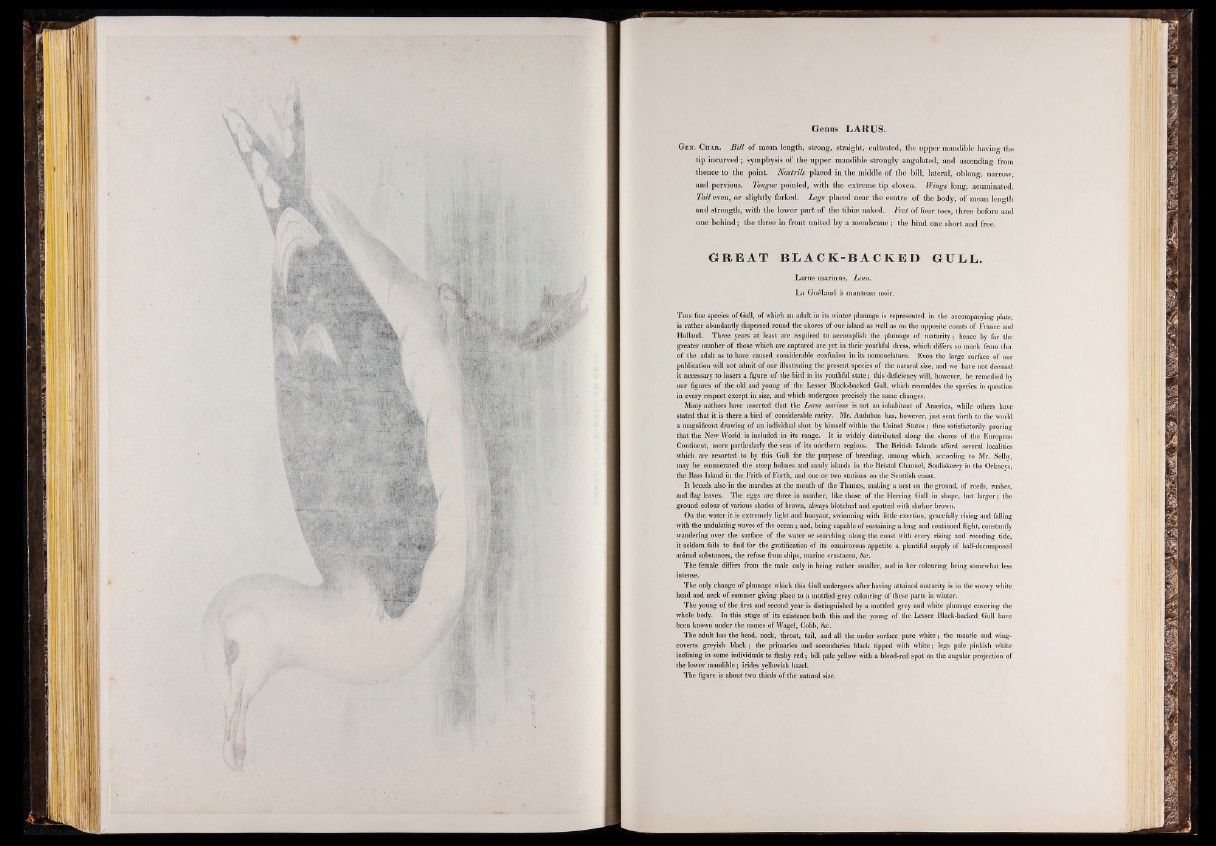
m
Ü ü
1 * 1
Ü Ü i
W
m â
M m
Genus LARUS.
Gen . Char. B ill o f mean length, strong, straight, cultrated, the upper mandible having the
tip incurved ; symphysis o f the upper mandible strongly angulated, and ascending from
thence to the point. Nostrils placed in the middle o f the bill, lateral, oblong, narrow,
and pervious. Tongue pointed, with the extreme tip cloven. Wings long, acuminated.
Tail even, or slightly forked. Legs placed near the centre o f the body, o f mean length
and strength, with the lower part o f the tibiae naked. Feet o f four toes, three before and
one behind ; the three in front united by a membrane ; the hind one short and free.
G R EA T B L A C K -B A C K E D GULL.
Larus marin us, Linn.
La Goéland à manteau noir.
T his fine species of Gull, of which an adult in its winter plumage is represented in the accompanying plate,
is rather abundantly dispersed round the shores of our island as well as on the opposite coasts of France and
Holland. Three years at least are required to accomplish the plumage of maturity ; hence by far the
greater number of those which are captured are yet in their youthful dress, which differs so much from th a
of the adult as to have caused considerable confusion in its nomenclature. Even the large surface of our
publication will not admit of our illustrating the present species of the natural size, and we have not deemed
it necessary to insert a figure of the bird in its youthful state ; this deficiency will, however, be remedied by
our figures of the old and young of the Lesser Black-backed Gull, which resembles the species in question
in every respect except in size, and which undergoes precisely the same changes.
Many authors have asserted that the Larus marinus is not an inhabitant of America, while others have
stated that it is there a bird of considerable rarity. Mr. Audubon has, however, just sent forth to the world
a magnificent drawing of an individual shot by himself within the United States ; thus satisfactorily proving
that the New World is included in its range. It is widely distributed along the shores of the European
Continent, more particularly the seas of its northern regions. The British Islands afford several localities
which are resorted to by this Gull for the purpose of breeding, among which, according to Mr. Selby,
may be enumerated the steep holmes and sandy islands in the Bristol Channel, Souliskerry in the Orkneys,
the Bass Island in the Frith of Forth, and one or two stations on the Scottish coast.
It breeds also in the marshes at the mouth of the Thames, making a nest on the ground, of reeds, rushes,
aud flag leaves. The eggs are three in number, like those of the Herring Gull in shape, but larger ; the
ground colour of various shades of brown, always blotched and spotted with darker brown.
On the water it is extremely light and buoyant, swimming with little exertion, gracefully rising and falling
with the undulating waves of the ocean ; and, being capable o f sustaining a long and continued flight, constantly
wandering over the surface of the water o r searching along the coast with every rising and receding tide,
it seldom fails to find fo r the gratification o f its omnivorous appetite a plentiful supply o f half-decomposed
animal substances, the refuse from ships, marine Crustacea, &c.
The female differs from the male only in being rather smaller, and in her colouring being somewhat less
intense.
The only change of plumage which this Gull undergoes after having attained maturity is in the snowy white
head and neck of summer giving place to a mottled grey colouring of these parts in winter.
The young of the first and second year is distinguished by a mottled grey and white plumage covering the
whole body. In this stage of its existence both this and the young of the Lesser Black-backed Gull have
been known under the names of Wagel, Cobb, &c.
The adult has the head, neck, throat, tail, and all the under surface pure white ; the mantle and wing-
coverts greyish black ; the primaries and secondaries black tipped with white ; legs pale pinkish white
inclining in some individuals to fleshy red ; bill pale yellow with a blood-red spot on the angular projection of
the lower mandible ; irides yellowish hazel.
The figure is about two thirds of the natural size.